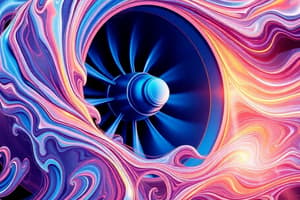Podcast
Questions and Answers
Which of the following is NOT a way in which energy can transfer across the boundary of a control volume?
Which of the following is NOT a way in which energy can transfer across the boundary of a control volume?
- Energy accompanying mass within the control volume (correct)
- Work
- Heat
- Energy accompanying mass as it enters or exits
What is the mass rate balance for control volumes with several inlets and exits expressed as?
What is the mass rate balance for control volumes with several inlets and exits expressed as?
- The quotient of the mass flow rates at each inlet and exit
- The difference between the mass flow rates at each inlet and exit
- The product of the mass flow rates at each inlet and exit
- The sum of the mass flow rates at each inlet and exit (correct)
Which of the following is true about the assumptions of one-dimensional flow and steady-state in control volume analysis?
Which of the following is true about the assumptions of one-dimensional flow and steady-state in control volume analysis?
- They are independent idealizations (correct)
- They are both necessary for control volume analysis
- They are always explicitly listed in the accompanying solved examples
- They are dependent idealizations
Flashcards
Energy Transfer Exclusion
Energy Transfer Exclusion
Energy accompanying mass within the control volume.
Mass Rate Balance
Mass Rate Balance
The sum of the mass flow rates at each inlet and exit.
1-D Flow & Steady-State
1-D Flow & Steady-State
They are independent idealizations.
Study Notes
Control Volume Analysis Using Energy
- The objective of the chapter is to develop and illustrate the use of the control volume forms of the conservation of mass and conservation of energy principles.
- Mass and energy balances for control volumes are introduced and applied to control volumes at steady state.
- Energy transfer across the boundary of a control volume can occur by means of work, heat, and the energy accompanying mass as it enters or exits.
- The conservation of mass principle for control volumes is developed and illustrated, and the one-dimensional flow model is introduced.
- The mass rate balance for control volumes is introduced, stating that the instantaneous mass flow rates at the inlet and exit must be equal.
- The mass rate balance for control volumes with several inlets and exits is expressed as the sum of the mass flow rates at each inlet and exit.
- One-dimensional flow is said to occur when the flow is normal to the boundary at locations where mass enters or exits the control volume and all intensive properties are uniform with position.
- The mass flow rate for one-dimensional flow can be evaluated using the formula 𝑚̇ = 𝐴V 𝑣.
- Many engineering systems can be idealized as being at steady state, meaning that all properties are unchanging in time.
- For a control volume at steady state, the total incoming and outgoing rates of mass flow are equal.
- The steady-state assumption and the one-dimensional flow assumption are independent idealizations.
- The assumptions of one-dimensional flow and steady-state are not explicitly listed in the accompanying solved examples.
Studying That Suits You
Use AI to generate personalized quizzes and flashcards to suit your learning preferences.





